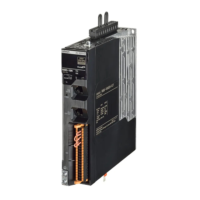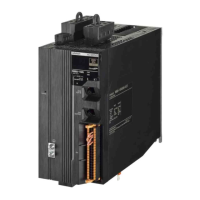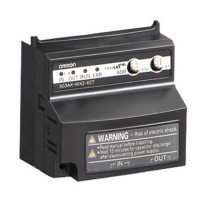7 - 7
7 Applied Functions
AC Servomotors/Servo Drives 1S-series with Built-in EtherCAT® Communications User’s Manual (I586)
7-1 General-purpose Input Signals
7
7-1-3 Function Input Details
This section explains the function inputs that can be allocated to the general-purpose inputs.
Error Stop Input (ESTP)
• This signal is used to forcibly generate an error to stop motor rotation from an external device.
• If the Error Stop Input (ESTP) signal turns ON during motor rotation, the Servomotor stops
according to the setting in the Stop Selection - Fault Reaction Option Code (3B20-04 hex).
• If the Error Stop Input (ESTP) signal turns ON when the Servomotor is energized, the Error Stop
Input (Error No. 87.00) will occur.
Positive Drive Prohibition Input (POT) and Negative Drive Prohibition Input
(NOT)
• These two input signals prohibit the positive and negative drive (over-travel).
• When these terminals are short-circuited (default setting), the Servo Drive can drive the Servomo-
tor in each rotation direction.
• In the drive prohibition state, the Servo Drive does not enter an error state.
• To use this function, set Drive Prohibition - Enable (3B10-01 hex) to 1.
• When Drive Prohibition - Enable (3B10-01 hex) is set to 1, you can select the operation at a
drive prohibition input in Drive Prohibition - Stop Selection (3B10-02 hex).
Home Proximity Input (DEC)
• This is the deceleration signal for homing.
• If the Home Proximity Input turns ON while the Servomotor is running at the Speed During
Search for Switch (3A00-03 hex), it will decelerate to Homing - Speed During Search for Zero
(3A00-04 hex).
External Latch Input (EXT1 and EXT2)
• These are the external input signals to latch the present position.
• The encoder position data is obtained at the rising edge when the External Latch Input is turned
ON.
Monitor Inputs (MON1 to MON8)
• These can be used as general-purpose monitor inputs.
• The general-purpose monitor inputs do not affect operation, and they can be monitored from the
host controller.
Positive Torque Limit Input (PCL) and Negative Torque Limit Input (NCL)
• The Positive Torque Limit Input (PCL) is used to switch the torque limit between the Positive
torque limit value (60E0 hex or 3330-03 hex) and Positive Torque Limit Value 2 (3330-05 hex).
• The Negative Torque Limit Input (NCL) is used to switch the torque limit between the Negative
torque limit value (60E1 hex or 3330-04 hex) and Negative Torque Limit Value 2 (3330-06
hex).
•Use the Torque Limit - Switching Selection (3330-01 hex) to select a method to switch the
torque limit.
7-1-3 Function Input Details

